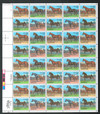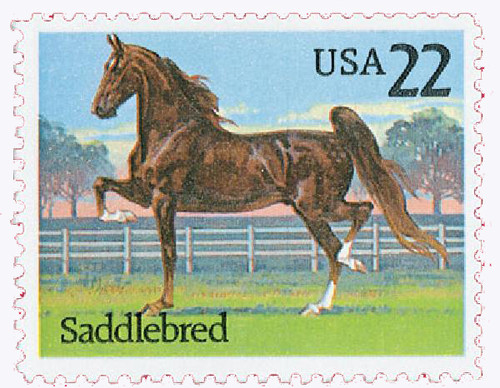
# 2155-58 - 1985 22c Horses
U.S. 2155-58
1985 22¢ Horses
- Pictures four popular horse breeds found in America
- First stamps to feature specific horse breeds as main subject
Stamp Category: Commemorative
Set: Horses
Value: 22¢, first-class rate
First Day of Issue: September 25, 1985
First Day City: Lexington, Kentucky
Quantity Issued: 147,940,000
Printed by: Bureau of Engraving and Printing
Printing Method: Photogravure
Format: Panes of 40 in sheets of 160
Perforations: 11
Why the stamps were issued: Horses have appeared on stamps as far back as 1869, when the 2¢ Postrider Pictorial depicted one in an unrealistic pose. Since then, horses have appeared on more than three dozen stamps, often as elements of a larger image commemorating a battle, statehood, the Olympics, and more.
This block of four was the first to honor specific breeds and depict them accurately. Organizations and individuals had suggested stamps honoring specific breeds for many years.
About the stamp designs: Roy Anderson provided the artwork for these stamps. The stamps were in part inspired by the popularity of the 1984 Dogs block, which was also created by Anderson. He created his stamp images in oils.
Some of Anderson’s first sketches for these stamps were found unsatisfactory by a horse expert. So, the USPS sent him to Kentucky to meet with equine experts to get their input to ensure the stamps were as accurate as possible.
First Day City: The First Day ceremony for this block was held at the Parade of Breeds Barn at Kentucky Horse Park in Lexington, Kentucky. The USPS had considered several locations where some of the breeds could be found. They ultimately selected this site because all four breeds were there and could be present during the ceremony.
History the stamps represent: First domesticated by nomadic peoples in the third millennium B.C., the horse was brought to the new world by the Spanish in the 1500s.
The Quarter Horse is known for its speed in sprinting short distances. Their name comes from their ability to outrun other breeds in races measuring a quarter mile or less. They have been known to run as fast as 44 miles per hour. It’s the most popular breed in the US and has the largest breed registry globally, with nearly three million registered worldwide. Quarter Horses perform well in races as well as rodeo performances, and for ranch work. They’re often used western riding events involving cattle as well as jumping, dressage, hunting, and other activities. It’s the state horse of Texas and Oklahoma.
The Morgan horse was one of the first breeds developed in the US. Early Morgans were used in harness racing, as riding animals, and by the cavalry during the Civil War. In 1907, the US Department of Agriculture created the US Morgan Horse Farm to maintain and improve on the breed, though the farm was later taken over by the University of Vermont. The Morgan is the state horse, mammal, or animal of several states: Vermont, Massachusetts, and Rhode Island.
The Saddlebred was previously known as the American saddle horse and the Kentucky Saddler. They’re often called the “Horse America Made,” and were bred during the American Revolution from the Narragansett Pacer, Canadian Pacer, Morgan and Thoroughbred, among others. They were often used by officers during the American Civil War. The Saddlebred has long been popular, with around 250,000 bred since the US first established a breed registry in 1891. Saddlebreds average 60 to 64 inches tall and known for being stylish, spirited, and gentle. Saddlebreds were often used in film, especially during the Golden Age of Hollywood, and compete in races and other competitions.
The Appaloosa is most often noted for its colorful spotted coat. It was originally bred by the Nez Perce, who called them the “Palouse horse,” likely after the Palouse River, which ran through their territory. Over time, the name became Appaloosa. One of the country’s most popular breeds, they’re often used as stock horses, in western riding, and in films. The Appaloosa is also the state horse of Idaho.
U.S. 2155-58
1985 22¢ Horses
- Pictures four popular horse breeds found in America
- First stamps to feature specific horse breeds as main subject
Stamp Category: Commemorative
Set: Horses
Value: 22¢, first-class rate
First Day of Issue: September 25, 1985
First Day City: Lexington, Kentucky
Quantity Issued: 147,940,000
Printed by: Bureau of Engraving and Printing
Printing Method: Photogravure
Format: Panes of 40 in sheets of 160
Perforations: 11
Why the stamps were issued: Horses have appeared on stamps as far back as 1869, when the 2¢ Postrider Pictorial depicted one in an unrealistic pose. Since then, horses have appeared on more than three dozen stamps, often as elements of a larger image commemorating a battle, statehood, the Olympics, and more.
This block of four was the first to honor specific breeds and depict them accurately. Organizations and individuals had suggested stamps honoring specific breeds for many years.
About the stamp designs: Roy Anderson provided the artwork for these stamps. The stamps were in part inspired by the popularity of the 1984 Dogs block, which was also created by Anderson. He created his stamp images in oils.
Some of Anderson’s first sketches for these stamps were found unsatisfactory by a horse expert. So, the USPS sent him to Kentucky to meet with equine experts to get their input to ensure the stamps were as accurate as possible.
First Day City: The First Day ceremony for this block was held at the Parade of Breeds Barn at Kentucky Horse Park in Lexington, Kentucky. The USPS had considered several locations where some of the breeds could be found. They ultimately selected this site because all four breeds were there and could be present during the ceremony.
History the stamps represent: First domesticated by nomadic peoples in the third millennium B.C., the horse was brought to the new world by the Spanish in the 1500s.
The Quarter Horse is known for its speed in sprinting short distances. Their name comes from their ability to outrun other breeds in races measuring a quarter mile or less. They have been known to run as fast as 44 miles per hour. It’s the most popular breed in the US and has the largest breed registry globally, with nearly three million registered worldwide. Quarter Horses perform well in races as well as rodeo performances, and for ranch work. They’re often used western riding events involving cattle as well as jumping, dressage, hunting, and other activities. It’s the state horse of Texas and Oklahoma.
The Morgan horse was one of the first breeds developed in the US. Early Morgans were used in harness racing, as riding animals, and by the cavalry during the Civil War. In 1907, the US Department of Agriculture created the US Morgan Horse Farm to maintain and improve on the breed, though the farm was later taken over by the University of Vermont. The Morgan is the state horse, mammal, or animal of several states: Vermont, Massachusetts, and Rhode Island.
The Saddlebred was previously known as the American saddle horse and the Kentucky Saddler. They’re often called the “Horse America Made,” and were bred during the American Revolution from the Narragansett Pacer, Canadian Pacer, Morgan and Thoroughbred, among others. They were often used by officers during the American Civil War. The Saddlebred has long been popular, with around 250,000 bred since the US first established a breed registry in 1891. Saddlebreds average 60 to 64 inches tall and known for being stylish, spirited, and gentle. Saddlebreds were often used in film, especially during the Golden Age of Hollywood, and compete in races and other competitions.
The Appaloosa is most often noted for its colorful spotted coat. It was originally bred by the Nez Perce, who called them the “Palouse horse,” likely after the Palouse River, which ran through their territory. Over time, the name became Appaloosa. One of the country’s most popular breeds, they’re often used as stock horses, in western riding, and in films. The Appaloosa is also the state horse of Idaho.













